Asus Zenbook 14 Pro OLED review: Big power in a small package

 Image: Mattias Inghe
Image: Mattias Inghe At a glance
At a glance
Expert’s Rating
Pros
Hefty performance for a 14-inch deviceCrisp oled displayTop-notch keyboard and mouse padSturdy, durable chassis
Cons
Can get hot to play onSome fiddling with settings
Our Verdict
If you’re looking for serious power in a tiny package, the Asus Zenbook 14 Pro OLED is the one to pick.
Price When Reviewed
$1799
Best Prices Today: Asus Zenbook 14 Pro OLED
RetailerPrice

 $1799.99View Deal
$1799.99View Deal $1799.99View DealPrice comparison from over 24,000 stores worldwideProductPricePrice comparison from Backmarket
$1799.99View DealPrice comparison from over 24,000 stores worldwideProductPricePrice comparison from Backmarket
The new Zenbook 14 Pro OLED is a compact computer that, despite its small dimensions, packs a lot of performance under the hood. The higher tier configuration features an Intel Core i9-13900H CPU and a GeForce RTX 4070 GPU and can thus challenge beefy gaming laptops in pure brute force. The model I have for testing is more modest and has a simpler Core i7-13700H and RTX 4060 instead. It also has 16 gigabytes of RAM instead of 32.
My review unit isn’t the most powerful configuration, but that’s still a lot of power for such a small laptop. I can easily fire up Adobe Premiere Pro and cut or color grade 4K film in multiple layers, browse photo libraries at lightning speed, and twist and turn 3D objects in Blender. You may want to avoid being overly ambitious and trying to do all three at once due to the limited RAM. But even that is possible. Read on to learn more.
Looking for more options? Check out PCWorld’s roundup of the best laptops available today.
Asus Zenbook 14 Pro OLED: Specifications
Processor: Intel Core i9-13700H, 6pcs Peformance up to 5 GHz, 8pcs Efficient up to 3,7 GHz
Graphics: Nvidia GeForce RTX 4060 Laptop, 8GB
Memory: 16GB DDR5
Storage: 1TB SSD, slot for SD card
Displays: 14.5 inch glossy OLED, 2880×1800 pixels, 120 Hz
Webcam: 1080p with 3dnr, ir for Windows Hello
Connections: 2 Thunderbolt 4, USB 3 Gen 2 Type A, HDMI, headset
Wireless: Wi-Fi 6e, Bluetooth 5.3
Operating system: Windows 11 Pro
Other: Backlit keyboard, Asus Dial
Noise level: 0-39 dBa
Battery life: Two hours 10 minutes (high load, full brightness), about eight hours (low load, low brightness)
Size: 32.2 x 22.3 x 1.8 cm
Weight: 3.63 lbs
Price: $2,299.31
Asus Zenbook 14 Pro OLED: Performance
Cinebench R23, CPU: 15,357 points
Cinebench R23, CPU single core: 1,884 points
Geekbench 6, CPU: 11,214 points
Geekbench 6, CPU single core: 2,559 points
Geekbench 6, GPU: 87,663 points
Disk read: up to 6,996.16 MB/s
Disk write: up to 5,221.14 MB/s
Asus Zenbook 14 Pro OLED: Manages heat to some extent
You can play games on your computer even if that’s not what it’s primarily built for. With its little-more-than-2k resolution and 120 Hz frequency, the graphics card isn’t really suited for maintaining a steady 60 Hz in games, but lower the ambition and resolution and even heavy titles can run smoothly. For a while anyway, the computer has a tendency to throttle down performance somewhat during longer periods of maximum load. Not surprising considering the small space for cooling and fans.
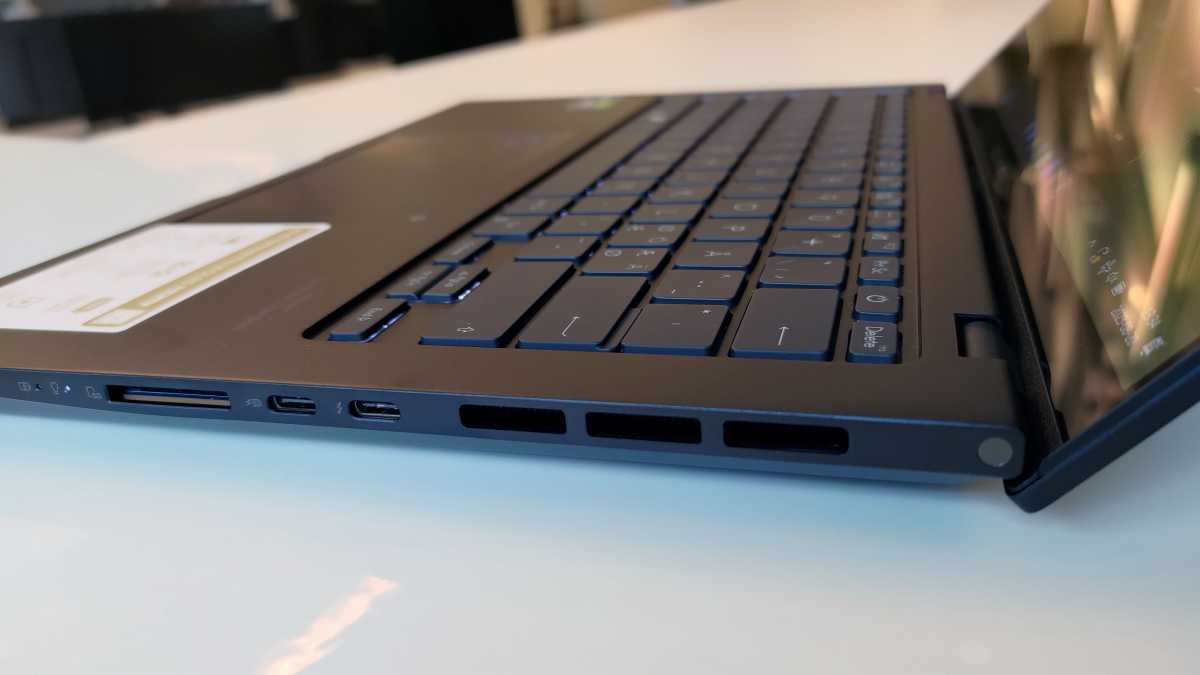
Mattias Inghe
Mattias Inghe
Mattias Inghe
But only for the graphics card. You can push the processor for hours without any loss of performance. However, the underside of the computer gets hot quickly, so it’s best to keep it on a table and not in your lap. It only gets noticeably hot on the top of the keyboard when the graphics card is working at full speed.
The computer may be compact, but it’s not particularly thin and light. It’s almost two centimeters at its thickest point and weighs 3.63 pounds. Its rather angular shape also makes it less comfortable to carry around. The chassis is solid matte aluminium with dark surfaces, and the sides and back are covered with large cooling grids. There is still room for the expected set of connections, dual thunderbolt 4, a large USB port, a normal sized HDMI and headphone jack.
Unusual to see in this small format is that it has a separate charging port instead of getting power from one of the type c ports. But then again, this is a performance computer with performance hardware. The charger is a hefty block, as thick as the computer, and weighs an extra couple of kilos to carry around. Three if you include the wall plug cable.
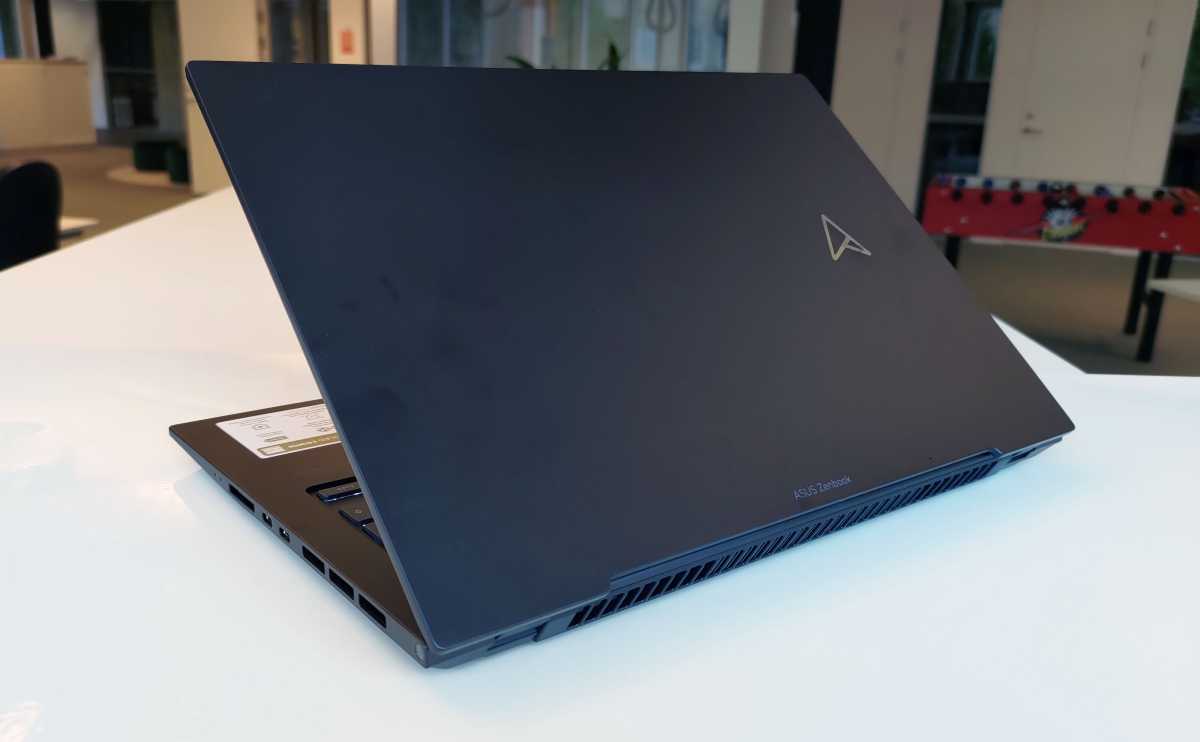
Mattias Inghe
Mattias Inghe
Mattias Inghe
Asus Zenbook 14 Pro OLED: Spacious keyboard and smart extra controls
The “14” in the name stands for 14 inches in screen size, but it’s a bit bigger than most 14 inchers, with a 14.5 inch surface. That also makes it a few millimetres wider than a standard 13.3 or 14-inch. This may seem marginal, and for the most part it is. However, it leaves a little more room for the keyboard, which, despite having margins at the edges, has full-sized, properly spaced keys. It’s also very well built. Buttons have distinctive quality mechanics and the stroke height is palpable.
The On button is in the top row between Print Screen and Delete. There is a certain risk of accidental access, but with a slightly smarter placement than in other computers and with higher pressure resistance, Asus avoids the biggest risks. The backlighting is never more than half-strength in the keyboard, but it’s enough to keep you from drifting in the dark.
Underneath is a large mouse pad with good control. A recessed ring in the top left corner provides special controls that emulate a dial control, allowing you to “turn” it with your fingertip.
The Asus Dial feature, which pops up a round menu on the screen when I tap the “dial”, can be linked to controls such as volume and brightness, and also control some features in Microsoft Office and Adobe Creative Cloud. You can also build your own menu wheels with optional settings and features in the system. Although it is frustratingly complicated to do. After years of this feature in various Zenbook and ProArt computers, it’s a shame that it hasn’t been developed more and that you can’t get direct support for sliders in more programs. It’s up to third-party developers to integrate, and that’s apparently not appealing enough.
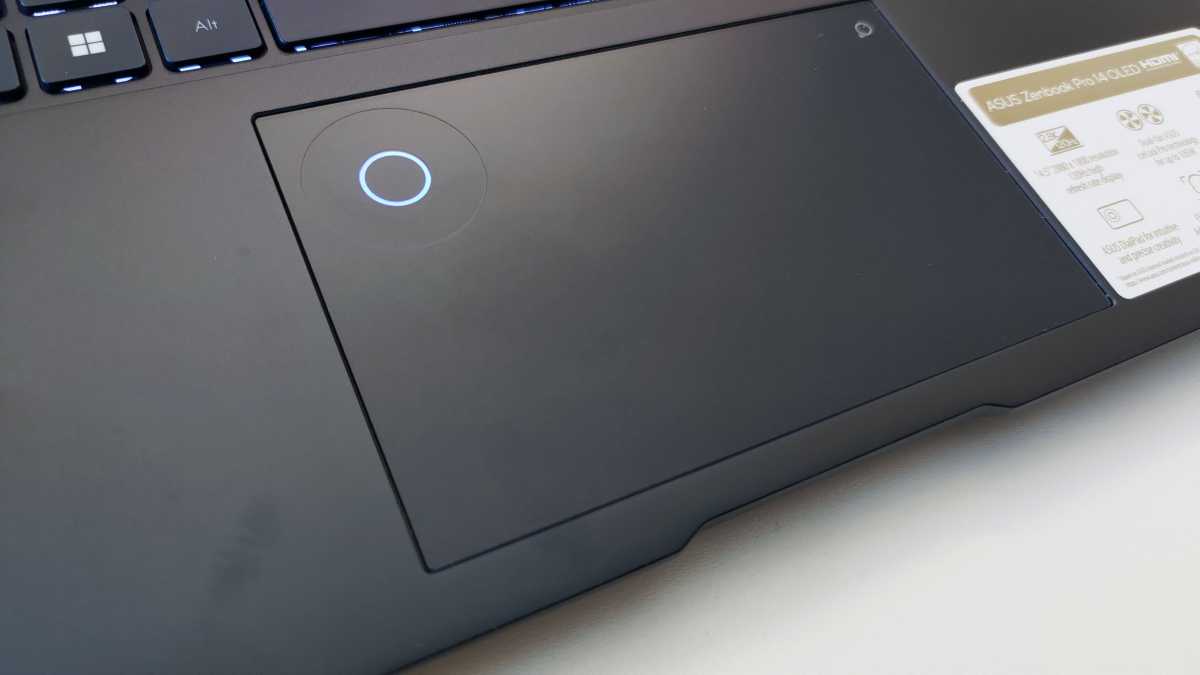
Mattias Inghe
Mattias Inghe
Mattias Inghe
Asus Zenbook 14 Pro OLED: Top class screen
With OLED in the name, it is of course OLED in the screen. But here you get a nice, sharp and colorful OLED screen with all the good qualities that it brings with it. The resolution of 2880 x 1800 pixels makes it so dense that I have to lean really close to distinguish individual pixels.
You get perfect contrast down to the smallest pixel, intense colors with excellent control and color accuracy, and even short response times for when you want to play games. The color gamut goes up to at least dci p3 level, and the screen delivers both display p3 and SRGB almost perfectly, and is even so close to AdobeRGB that it’s not noticeable that it misses by a couple of percent.
That’s for sdr image, and a brightness of up to about 350 cd/m2. If you want peaked dynamics, you can also switch to HDR mode in the Windows screen settings, then you get just over 500 cd/m2 in spot brightness, but not with calibrated color accuracy. You can choose between srgb, dci-p3, display p3 and “Native” for color gamut from Asus’ own settings, where you can also manually adjust the color temperature and blue light filter.
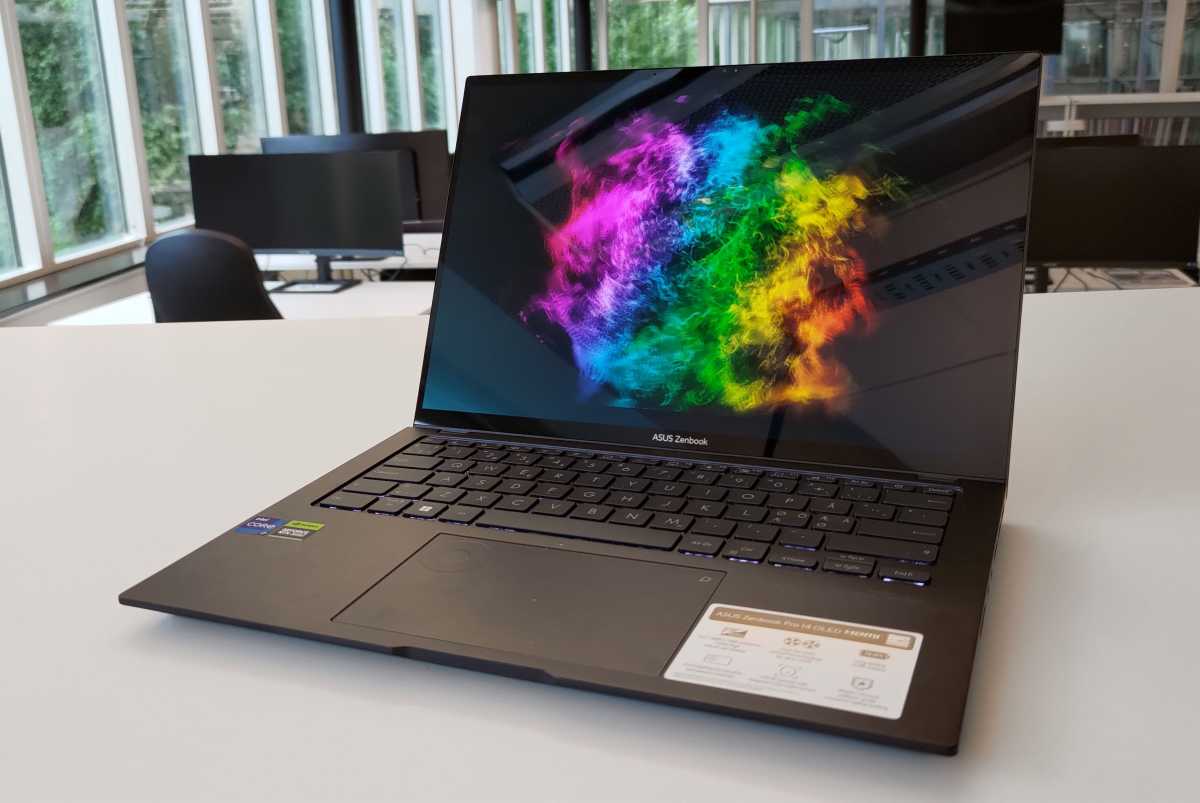
Mattias Inghe
Mattias Inghe
Mattias Inghe
Asus Zenbook 14 Pro OLED: App confusion
This is done in the My Asus application where you also have controls for network optimization, keyboard settings, battery charging and fans. Then there’s ProArt Creator Hub, where you can control the same fans, and make a handful of other settings, as well as professionally calibrate the screen if you have a compatible calibrator. Asus should consider merging these two programs. It just gets confusing to have so many separate apps.
The screen has touch support which gives good direct control. And some fingerprints to remove from the otherwise glossy surface. It can cause a bit of trouble if you have dark surfaces to look at in a bright room, as reflections become apparent, but for the most part it’s not a problem, especially if you turn up the brightness slightly.
Well-sounding if not spectacularly good speakers sit on the underside of the computer. They provide clear bass and treble and a midrange well suited to voice reproduction. It may not be a hi-fi experience for playing music, but it’s acceptable for most things. Small but good microphones in the computer provide excellent noise-free voice pickup, and the webcam is good enough. It’s always a bit of a lottery in Asus laptops, but here it delivers a mostly good picture, some noise in dark environments but otherwise nothing significant to complain about.
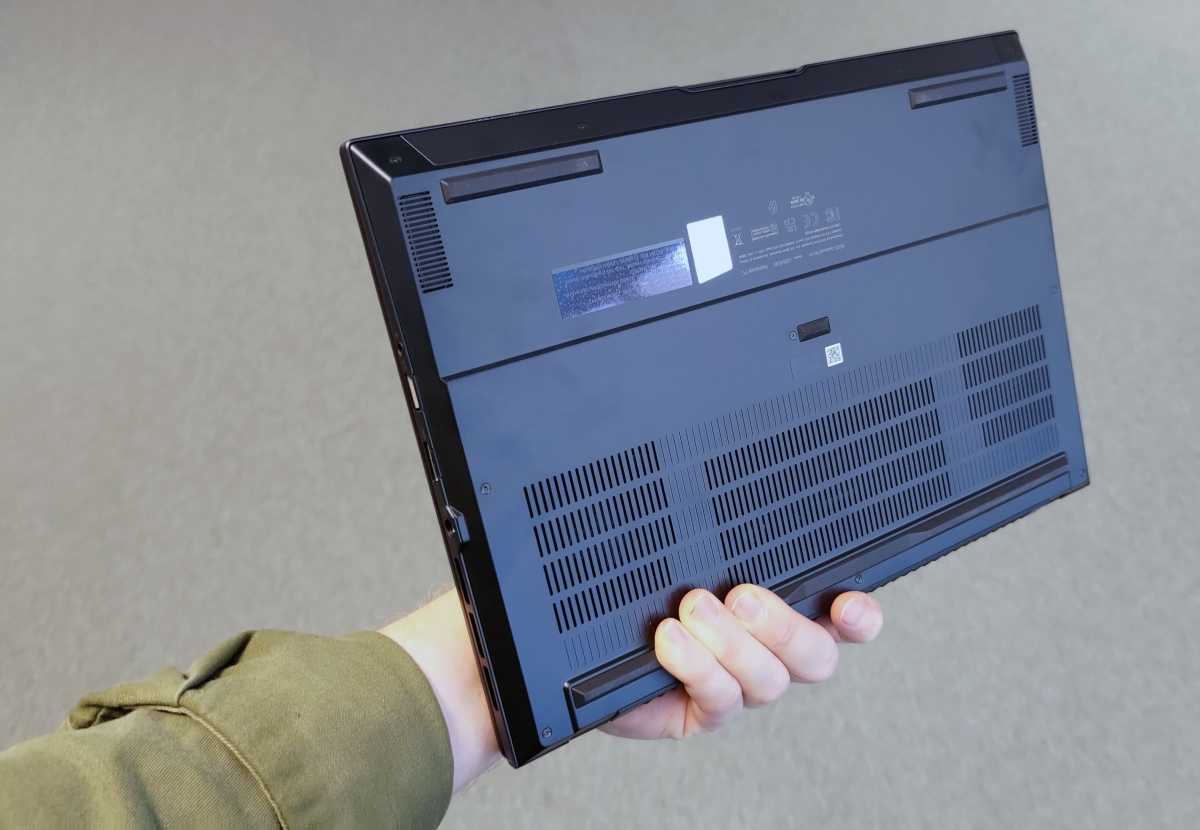
Mattias Inghe
Mattias Inghe
Mattias Inghe
Despite its compact size, the Zenbook 14 Pro OLED can do pretty much everything. Edit photos and film, compile code or manipulate 3D models. Even play games. No problem. Want to do everything on a tiny 14-inch screen in a laptop that will often need an umbilical cord to a wall socket? Because you’ll need it when the computer can’t perform at its peak for more than a couple of hours at most. That’s the question.
This article is a translation from our Swedish site.
Best Prices Today: Asus Zenbook 14 Pro OLED
RetailerPrice

 $1799.99View Deal
$1799.99View Deal $1799.99View DealPrice comparison from over 24,000 stores worldwideProductPricePrice comparison from Backmarket
$1799.99View DealPrice comparison from over 24,000 stores worldwideProductPricePrice comparison from Backmarket
Author: Mattias Inghe, Testredaktör PC för Alla

Jag testar datorer, datortillbehör, smartphones och mycket mer. Har du förslag på prylar du vill att vi testar – kontakta mig!
Recent stories by Mattias Inghe:
Asus ROG Zephyrus G16 review: A rip-roaring laptop for gamers and creatorsAsus Zenbook Duo 2024 review: A near-perfect dual screen laptopHP Laptop 14 review: A stylish, portable laptop for under $500





